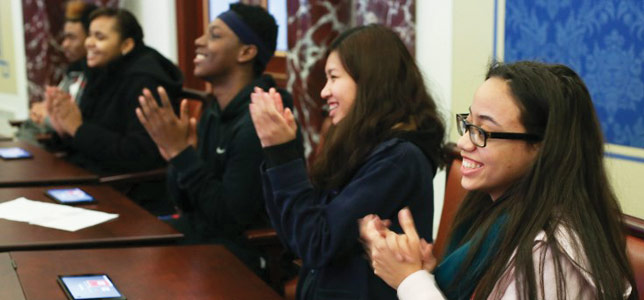Mobile Computing
A Teacher Shares His Lessons Learned From a Simulated Senate

Michael K. Milton teaches freshman and junior social studies at Burlington High School (MA). He also serves as a member of the Teacher Advisory Board of the Edward M. Kennedy Institute, which has combined tablets with a simulated Senate chamber to create Senate Immersion Modules (SIMs) designed to teach students how the legislature works. In this Q&A, he shares what teachers and students can learn from getting out of the classroom and into the Senate.
THE Journal: What was your pedagogical goal in using the modules?
Milton: There are some great lessons on the content of the SIMs that teachers can adapt and use prior to and after attending, but the purpose for the simulation is not to necessarily learn content, but rather to interpret, evaluate, argue and make decisions. For instance, while one of the SIMs is about the Compromise of 1850 and you do learn the major causes of it, in your Senate role you are presented with information and have to decide what values are most important to you and what are you willing to negotiate. That is the crux of the simulation.
THE Journal: How does the process work?
Milton: First, students enter a replica of the U.S. Senate. It is gorgeous. Photos do not do it justice. Then students take a seat in the chamber, where there is a tablet. Depending on the module (historic versus modern) on their tablets participants are either given a historical senator or take a “Senate Selfie.” (The “Senate Selfies” are quite fun to take.)
From there, the president pro tempore (our main guide) swears in the new senators and sets the stage of the debate. That is my favorite part. Students actually take the oath of office. After some framing of the topic at hand, the new senators are whisked away to different committees. Some committees build the bill while others decide whether (or not) to appoint various nominees for office. This demonstrates the varied work of the Senate. After some horse-trading on amendments to the bill, the Senate gathers again to listen to students debate particular parts of the bill. Finally, there’s a roll-call vote where each senator is called to stand and proudly declare yea or nay.
The devices that students use to help facilitate the experience are used in such a way that they do not overpower, but provide a launching point to discussion. Students use their tablets to uncover information that they will use in their efforts to discuss, debate and occasionally make deals with their Senate colleagues. From start to finish, the SIM lasts about two-and-a-half hours.
A neat part about this is that no two students will have the same experience. From their individual profiles, to their political parties, to their committees, the day will vary from student to student. This makes a debriefing eye-opening and can provide an interesting perspective into the varied work of the Senate.
THE Journal: What was your students' reaction to the modules?
Milton: While my students have not participated yet, I’ve been able to see students from another high school go through the experience. The students initially took time getting into the roles, but soon became immersed in the game. Being forced to take a different perspective, they argued things they did not believe. One student remarked that they had no idea they would get so involved.
THE Journal: What do the modules teach that students couldn't have learned through books, articles and videos?
Milton: Books, articles, videos and even firsthand accounts do not put students in the Senate chamber debating with one another. They do not make students senators grappling with decisions, balancing their own feelings with those of their state and political party. Often, students just hear of the causes and outcomes in history, but this gets students to grapple with why individuals might have acted the way that they did. Ultimately, with the Senate Immersion Module, students get to play with history.
THE Journal: Any other thoughts or impressions to share?
Milton: I have had the opportunity not just to watch students get sworn in the Senate, but graduate students and teachers. The teachers who participated in our first professional development experience were all thrilled and wanted to bring their classes as soon as possible. Some teachers were trying to figure out how many trips it would take to bring their entire school! It is amazing to see technology and a live-action simulation blend together in a truly unique hybrid experience.
About the Author
Christopher Piehler is the former editor-in-chief of THE Journal.